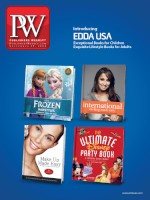Some in book publishing may dismiss the region that lies between and fans out from Lake Superior and Lake Michigan’s southern shores as “flyover country.” But besides the large bodies of water that define the region in so many ways, the western Great Lakes region—Minnesota, Wisconsin, Illinois—contain two major metropolitan areas: Chicago, ranked third in population after New York City and Los Angeles, and Minneapolis-St. Paul, ranked 16th. Both cities have become vibrant hubs of cultural activity in a region best known for its mix of industry and agriculture. The nation’s first—and still its largest—center dedicated to the literary arts, the Loft, is housed in a 55,000-sq.-ft. building called Open Book on the edge of downtown Minneapolis, and the Poetry Foundation and the American Library Association are both headquartered in Chicago; the American Writers Museum is scheduled to open there in 2015.
This is a region that also celebrates books and authors with annual festivals that draw crowds: the Chicago Tribune Printers Row Lit Fest just celebrated its 30th year in June, and the Twin Cities Book Festival celebrates its 14th year on October 11. The Wisconsin Book Festival officially takes place in half a dozen venues across Madison October 16–19, but schedules author events throughout the year. St. Paul’s Opus & Olives annual library system fund-raiser on October 12 and the Chicago Humanities Festival, having its 25th anniversary October 25–November 9, provide yet more opportunities for writers and readers to connect over books.
While the three states forming the western Great Lakes region contain 13% of the entire U.S. population of 316 million, with about half of those residents living in Chicagoland, the region more than holds its own when it comes to book publishing. According to the 2012 U.S. Census, 246 of the 2,885 book publishing companies in the country (excluding Internet-only companies) are headquartered in this tristate region, compared to 351 companies in New York state. While 16,628 New Yorkers work at book publishing houses, 4,484 Minnesotans and 3,957 Illinois residents are employed at such companies. (Employment statistics for Wisconsin’s 36 book publishers are unavailable.) While much of the literary activity in the region takes place in Minneapolis–St. Paul and in Chicago, even small cities—most notably Madison, Wis.; Champaign, Ill.; and Mankato, Minn.—boast thriving book publishing scenes.
There might be something in the water, or it may have to do with the Upper Midwest’s historically high literacy rates. It might be the impact of living in close proximity to some of the country’s most celebrated writers, including Garrison Keillor, Louise Erdrich, Kate DiCamillo, Stuart Dybek, and Scott Turow. Publishers in the region not only fill niches but also have the confidence to take risks that emerges from their doing business far from New York City’s large houses. It might simply be, as Graywolf publisher Fiona McCrae puts it, “We’re in the Midwest. We’re not going to behave like other publishers, necessarily.”
Below, more on western Great Lakes publishing.
Western Great Lakes: Land of 10,000 PressesMinnesota license plates proclaim that the state is the Land of 10,000 Lakes.
Western Great Lakes: Plenty of Room for Publishers in the City of the Big ShouldersChicago might be known for its burly swagger,” says the Chicago Tribune literary editor-at-large Elizabeth Taylor, “but it’s also a supportive place” for publishers and other literary folk to do business.
Western Great Lakes: Regional Publishing Takes Its PlaceScholarly presses fulfill their mission and broaden their reach by looking around them to build lists.
Western Great Lakes: All in the FamilyThe western Great Lakes region is home to a number of high-profile children’s book publishers.
Western Great Lakes: Midwestern NiceGreat Lakes booksellers are a collegial group.



 Volume 261
Issue 39
09/29/2014
Volume 261
Issue 39
09/29/2014





